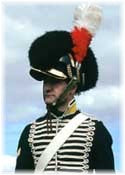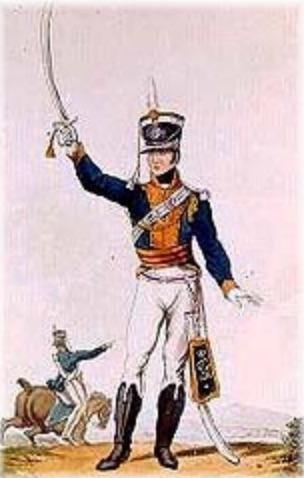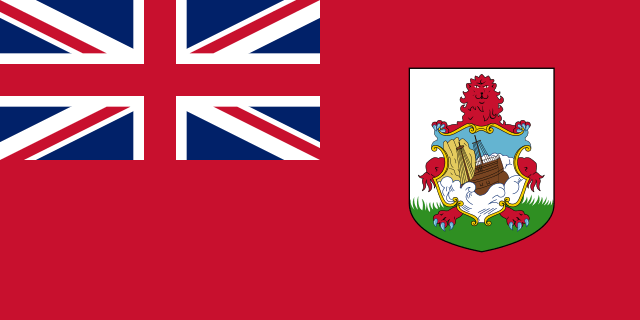Advancement in the British Army
 As explained in the article, " Aspiring to an Epaulette" the first step in an Officer’s career was to obtain the rank of Ensign (in the Infantry) or Coronet (in the Cavalry). Beyond lay the possibility of promotion to Lieutenant, and above. In peacetime, most promotions were acchieved by purchasing a higher rank. However, during the Napoleonic Wars, most progressions were made by promotions based first on seniority within the regiment to fill vacancies, second by merit, while Purchase came third. Advancement in the Ordnance Corps (Artillery and Engineers), as well as in the East India Company forces, was by Seniority only. A young Coronet or Ensign could advance to Lieutenant by paying the difference between his current and the next highest rank. [See Table of Commission Prices.] For example: a Lieutenancy cost £550, but an Ensign had already paid £400 to achieve that rank. He only needed to pay an additional £150 to make up the difference. As with the first purchase, this could only be done through the Regimental Agent. There were many regulations stating that no other moneys, or other incentives could be offered. The penalty for trying to pay more than the established price, was to immediately forfeit the Commission, and to be cashiered, while aiding and abetting constituted a Misdemeanor. Advancement above the rank of Colonel was by seniority only.
As explained in the article, " Aspiring to an Epaulette" the first step in an Officer’s career was to obtain the rank of Ensign (in the Infantry) or Coronet (in the Cavalry). Beyond lay the possibility of promotion to Lieutenant, and above. In peacetime, most promotions were acchieved by purchasing a higher rank. However, during the Napoleonic Wars, most progressions were made by promotions based first on seniority within the regiment to fill vacancies, second by merit, while Purchase came third. Advancement in the Ordnance Corps (Artillery and Engineers), as well as in the East India Company forces, was by Seniority only. A young Coronet or Ensign could advance to Lieutenant by paying the difference between his current and the next highest rank. [See Table of Commission Prices.] For example: a Lieutenancy cost £550, but an Ensign had already paid £400 to achieve that rank. He only needed to pay an additional £150 to make up the difference. As with the first purchase, this could only be done through the Regimental Agent. There were many regulations stating that no other moneys, or other incentives could be offered. The penalty for trying to pay more than the established price, was to immediately forfeit the Commission, and to be cashiered, while aiding and abetting constituted a Misdemeanor. Advancement above the rank of Colonel was by seniority only.  In the late 1790’s it became apparent that some officers had proceeded too quickly through the ranks, and had not gained the necessary training and experience to fulfill their role on the battlefield.
In the late 1790’s it became apparent that some officers had proceeded too quickly through the ranks, and had not gained the necessary training and experience to fulfill their role on the battlefield.
In 1795 the Duke of York instituted a series of reforms. Amongst these were Regulations outlining the minimum number of years an officer needed to serve at each step. A Subaltern (Lieutenant and below) had to serve at least three years before becoming a Captain; at least seven years in service (two as Captain) to become a Major; and nine years in service to be a Lieutenant-Colonel. However, lack of vacancies, or money, could mean that an officer (especially in the junior ranks) could spend several years without advancing. Let us take for example, how Frederick Tilney, in Jane Austen’s Northanger Abbey, might have reached the rank of Captain in the 12th Light Dragoons.
Although it appears to have been set in 1798 (putting part of Frederick’s military career before the Duke of York’s Reforms) let's assume he advanced in a less accelerated manner:  Upon the age of 16 he (or more likely his father) would have placed the sum of £735, and Letters of Recommendation with a Regimental Agent. (Those of associates of an Officer like the senior Tilney would lend some weight.) Once he was accepted, the £735 was "paid" to a Coronet who wished to be promoted (or quit the service) and Frederick became a Coronet. However, it was very likely it would be with a Cavalry Regiment other than the 12th. He then spent a year or two learning his duties under the tutelage of his senior officers. When a Lieutenancy opened, an additional £262-10s was deposited with the Agents (to make up the £997-10s). That money would be credited to the holder of the desired Lieutenancy (which again could be in a different Regiment), while Tilney’s Coronet was sold to another civilian desiring to enter the army. Finally, after a year or two, the Captaincy in the 12th Light Dragoons opened up, and £1785 was transferred to the Agents (which, with the sums already paid, totaled £2782-10s), and Frederick gained the rank and position described in Northanger Abbey. (Meanwhile, a Coronet would buy Tilney’s Lieutenancy, whilst selling his own Coronet to another would-be hero, and so on.)
Upon the age of 16 he (or more likely his father) would have placed the sum of £735, and Letters of Recommendation with a Regimental Agent. (Those of associates of an Officer like the senior Tilney would lend some weight.) Once he was accepted, the £735 was "paid" to a Coronet who wished to be promoted (or quit the service) and Frederick became a Coronet. However, it was very likely it would be with a Cavalry Regiment other than the 12th. He then spent a year or two learning his duties under the tutelage of his senior officers. When a Lieutenancy opened, an additional £262-10s was deposited with the Agents (to make up the £997-10s). That money would be credited to the holder of the desired Lieutenancy (which again could be in a different Regiment), while Tilney’s Coronet was sold to another civilian desiring to enter the army. Finally, after a year or two, the Captaincy in the 12th Light Dragoons opened up, and £1785 was transferred to the Agents (which, with the sums already paid, totaled £2782-10s), and Frederick gained the rank and position described in Northanger Abbey. (Meanwhile, a Coronet would buy Tilney’s Lieutenancy, whilst selling his own Coronet to another would-be hero, and so on.)
It should be noted that although an Officer’s commission was "sold," he did not receive the money directly, and would not recover it until he quit the service. As stated above, there were other means of gaining promotion, including seniority and merit. An officer’s Seniority in the Army was primarily established by the date of his commission as it appeared in the London Gazette. However, it was also often necessary to determine a man’s seniority within the Regiment (for example, when he officially joined the unit). This was especially true where an officer transferred from one Regiment to another, or came off "Half-Pay." Holding Seniority within the Army would entitle one to an available Purchase, whilst standing within the Regiment would decide who filled a non-purchase position created by the death or incapacity of another Officer.
Of course, the outsider who bought a position within the Regiment, by virtue of having paid for it, had a more secure hold on the rank, than the officer whose advance was by non-purchase means. Purchases from outside were more prevalent for the "Field Ranks" (Majors, Lieutenant-Colonels and Colonels).  There were many possible variations. If an Ensigncy in the Infantry had been received "free," he could still pay the extra £100 to be a Lieutenant. However, when he sold out he could only recover the extra £100. It was possible to sell a "free" commission, but it was discouraged, as it reduced the number of possible non-purchase openings. More often, one received an appointment to a Veteran Battalion, or went on Half-Pay. Some Half Pay Officers went on Staff. Originally, Half-Pay was a means by which an Officer could be put into semi-retirement while his services were not immediately needed. He would, as the term infers, receive half his regular pay while remaining at home waiting to be called back to active service. It also was designed to help support officers who could not find anyone to buy their commissions. This also had the advantage of saving the Government money. Those physically unfit for active service could be posted to Half-Pay Regiments, which were a kind of phantom organization.
There were many possible variations. If an Ensigncy in the Infantry had been received "free," he could still pay the extra £100 to be a Lieutenant. However, when he sold out he could only recover the extra £100. It was possible to sell a "free" commission, but it was discouraged, as it reduced the number of possible non-purchase openings. More often, one received an appointment to a Veteran Battalion, or went on Half-Pay. Some Half Pay Officers went on Staff. Originally, Half-Pay was a means by which an Officer could be put into semi-retirement while his services were not immediately needed. He would, as the term infers, receive half his regular pay while remaining at home waiting to be called back to active service. It also was designed to help support officers who could not find anyone to buy their commissions. This also had the advantage of saving the Government money. Those physically unfit for active service could be posted to Half-Pay Regiments, which were a kind of phantom organization.  Half-Pay Officers could in theory be recalled at any time. Many were called up during the 1798 Irish emergency. Other conditions were outlined.
Half-Pay Officers could in theory be recalled at any time. Many were called up during the 1798 Irish emergency. Other conditions were outlined.
An Officer could not collect half pay while in Holy Orders, nor take office with a foreign army (although this did not always apply to East India Company officers). When an officer went on H-P, he received the "difference," and paid it when he came off Half-Pay. It was also possible to buy H-P commissions (a civilian could not do so), that is a H-P Captain could buy out a H-P Major, although reasons for doing so are vague. Possibilities for advancement opened up in other ways. The great expansion of the Army during the Wars led to the creation of Second Battalions (that is, another Battalion within the same Regiment). Often promotions led to exchanges between the two. For example, the senior Lieutenant in the 1st Battalion upon being promoted would transfer to become the junior Captain in the Second. This allowed the "junior" unit to acquire experienced leaders. (Of course, with one of the Battalions serving overseas, transfers could take months, especially if one needed to wait for their replacement to arrive.)  "Merit" was another possible means of advancement. If a junior officer performed an exemplary act of courage, or decisiveness in battle, he might receive a promotion. One means was to join a "forlorn hope" During the siege of an enemy fortress, artillery pound the walls to form a "breech." The enemy, of course, would do its utmost to defend the breech. Booby-traps, and other unpleasant surprises would be prepared, and extra forces would be placed near the opening. The job of the Forlorn Hope was to make the enemy trigger the traps, and get a foothold in the breech, while under heavy enemy fire. The Lieutenant who led the Hope was assured of a Captaincy (should he survive), and the two Sergeants would become Ensigns.
"Merit" was another possible means of advancement. If a junior officer performed an exemplary act of courage, or decisiveness in battle, he might receive a promotion. One means was to join a "forlorn hope" During the siege of an enemy fortress, artillery pound the walls to form a "breech." The enemy, of course, would do its utmost to defend the breech. Booby-traps, and other unpleasant surprises would be prepared, and extra forces would be placed near the opening. The job of the Forlorn Hope was to make the enemy trigger the traps, and get a foothold in the breech, while under heavy enemy fire. The Lieutenant who led the Hope was assured of a Captaincy (should he survive), and the two Sergeants would become Ensigns.
By a bit of a twist of logic, it was felt that promotion by merit could lead to an excess of patronage, something objected to on political and professional grounds..In some cases there was an element of discrimination. For example, there was a "victory" brevet in 1814 that advanced all officers with commissions dated on or before the outbreak of War in 1803.  There were also local brevets, such as that granted to East India Company officers to put them on the same footing as Regular Officers serving east of the Cape of Good Hope. Otherwise, brevets could be given for exceptional services, or to give an officer a local command. (Thus a Captain could be a Lieutenant-Colonel for a given region; he would hold the seniority and pay of Captain, but receive the Allowances and other perks of being Lieutenant-Colonel.) A brevet rank could not, of course, be sold. Readers may also be interested in some related information originally posted on the "Life & Times of Jane Austen" Board at The Republic of Pemberley Website:
There were also local brevets, such as that granted to East India Company officers to put them on the same footing as Regular Officers serving east of the Cape of Good Hope. Otherwise, brevets could be given for exceptional services, or to give an officer a local command. (Thus a Captain could be a Lieutenant-Colonel for a given region; he would hold the seniority and pay of Captain, but receive the Allowances and other perks of being Lieutenant-Colonel.) A brevet rank could not, of course, be sold. Readers may also be interested in some related information originally posted on the "Life & Times of Jane Austen" Board at The Republic of Pemberley Website:
- Officers’ Pay
- Rise in rank
- Ranking amongst officers
- Resigning Commissions
Jason Everett has been a re-enactor since 1982 with a group representing a red-coated Canadian regiment of the War of 1812. For the past five years he has been its Commanding Officer. Other interests include Modern Ballroom, and Regency Country Dancing. Military Re-enactment Society of Canada / Incorporated Militia of Upper Canada Some pictures provided by the "British Napoleonic Light Cavalry Living History and Re-Enactment Society" The 12th (Prince of Wales’) Light Dragoons is a living history unit aiming to recreate one of the finest British light cavalry regiments to serve in the Napoleonic wars. The Unit provides displays of living history, drill and skill-at-arms throughout the UK as well as participating in battle re-enactments and commemorative events in this country and abroad. The Unit is a non-profit making organization dedicated to the highest standards of living history.



1 comment
I’m an author, pen name Michael Aye. I have been researching British army officer ranks during the late 1700’s. I have found your article the single most beneficial piece of information found on the subject. Thank you for writing such a wonderful article.
Mike Fowler
Leave a comment
This site is protected by hCaptcha and the hCaptcha Privacy Policy and Terms of Service apply.